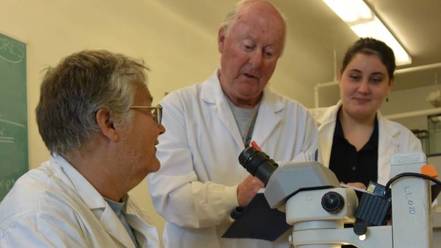Of 400 ticks collected, 98% were black legged ticks which can transmit Lyme disease Photo of Dr Vett Lloyd and colleagues Courtesy of CBC Photo of Dr Vett Lloyd and colleagues Courtesy of CBC Excellent article by CBC about Lyme disease carrying ticks on PEI and the research of Dr Vett Lloyd from Mt Alison University. Dr Lloyd is a Lead Researcher of the Canadian Lyme Consortium (CLC) - a Canadian research network focused on Lyme disease with a model of patient-research-clinician engagement at all levels for all projects by conducting meaningful science and investigating questions that matter to patients and matter to the healthcare professionals who treat patients - see more info on the Canadian Lyme Consortium (CLC) in link below. Many Canadians chose PEI as their summer destination of choice and so this information is vitally important to be aware. 'Lloyd says more than 80 per cent had been picked up on Prince Edward Island, from people who hadn't travelled off the Island. The vast majority, she said, were the black legged ticks, formerly known as deer ticks, which can transmit Lyme disease.' 'The lab also tested blood samples from dogs across the Island. Lloyd said seven were infected with the Lyme disease bacteria and six of those had never left the Island.' Please also join almost 62000 Canadians in signing, commenting and sharing our Canadian Lyme Petition and issues around Lyme disease and the obstacles and road-blocks faced by Canadian sufferers need to be dismantled. Canadians who are currently sick with Lyme disease need recognition, treatment and support. Canadians who are concerned about Lyme disease need the appropriate tools, up-to-date treatment guidelines and resources to best deal with when they encounter a tick - whether it be the school-yard, golf course or back-yard. https://www.change.org/p/minister-petitpas-taylor-ticking-lyme-bomb-in-canada-fix-canada-s-lyme-action-plan-now More information on the Canadian Lyme Consortium (CLC) here: http://www.lymehope.ca/advocacy-updates/patient-first-research-patient-first-engagement-patient-first-values-and-preferences-patient-questions-making-an-informed-choice
2 Comments
Patient First Treatment for Ontarians with Lyme Disease - RNAO Resolution The Registered Nurses Association of Ontario (RNAO) voted through a resolution on Lyme disease 'Patient First Treatment for Ontarians with Lyme Disease' at their annual AGM conference in Toronto on Friday April 20th, 2018. A live recording of the resolution process and vote below. Please note, the Lyme resolution is the very first one addressed. https://www.facebook.com/RNAOHomeOffice/videos/10151012128169944/ **please note, 2 minor amendments were made to the below resolution adding in prevention programs for Lyme disease and strengthening some of the language used. We will update the resolution to reflect the changes with these amendments as soon as possible. Patient First Treatment for Ontarians with Lyme Disease Submitted on behalf of Halton Chapter Author: Sue Faber and co-authors: Catherine Kinsella, and Louela Manankil-Rankin. Authors declare no conflict of interest. Resolution: WHEREAS people with Lyme disease and/or co-infections in Ontario are not consistently receiving appropriate diagnosis and treatment of these diseases due to inadequate testing protocols and a lack of up to date education of medical professionals on the clinical diagnosis of these diseases; WHEREAS there is a lack of education and awareness regarding persistence of infection, transplacental transmission, co-infections, other possible modes of transmission (sexual, blood supply, needle sticks, organ donation and other insect vectors), symptoms (acute vs. chronic), surveillance of chronic cases, modes of testing, treatment, and the existence of up to date, evidence-based guidelines published by ILADS; WHEREAS these challenges along with the politicization of this disease has created fear and uncertainty amongst healthcare professionals thereby forcing patients with Lyme disease and/or co-infections to pay for out of Country testing and seek health care outside of Canada at their own expense; THEREFORE be it resolved that the Registered Nurses’ Association of Ontario (RNAO) advocate, at all levels of government, for the rights of all patients with symptoms consistent with Lyme and/or co-Infections to receive fair and proper treatment for both acute and multi-systemic chronic presentations of the disease in Canada; emphasizing healthcare provider education that acknowledges alternate modes of transmission, persistence of infection, and integration of a collaborative clinical model inclusive of ILADS guidelines in the treatment of this illness. Background: Lyme Disease is a serious and rapidly growing public health crisis in North America, caused by the bacterium Borrelia burgdorferi. It is spread by ticks that are carried by migratory birds and animals such as deer and mice. In 2016, there were an estimated 178,000 cases in US States bordering Ontario (Centers for Disease Control and Prevention, 2017). Canadian scientists predict that by the year 2020, 80% of the population of Eastern Canada will be living in a tick-populated area (Leighton, 2012). Limitations of current testing (Health Canada, 2012) and treatment protocols have left thousands of Canadians improperly diagnosed and inadequately treated for the disease. Many have been forced to seek treatment outside of Canada at their own expense resulting in financial hardship, significant stress and strain on families (Boudreau, Lloyd, Gould, 2017). Bill C442 was passed in 2014 with a mandate of creating a national strategy for Lyme Disease, embracing a collaborative process of all stakeholders including patients (Bill C442, 2014). In May 2017, the Federal Framework for Lyme Disease was released (Public Health Agency of Canada, 2017). In June 2017, the House of Commons Standing Committee on Health called for a study of the Federal Lyme Framework (HESA, 2017). Canadian patients, advocates, nurses, treating physicians, scientists, and researchers agree that the Lyme Framework failed its mandate and is insufficient to drive meaningful patient-centered change in Canada (HESA, 2017). It neglects to acknowledge the vast body of peer reviewed literature which documents persistence of infection resulting in chronic Lyme disease (International Lyme and Associated Diseases Society [ILADS], 2015) as well as clear evidence of vertical transmission from mother to child in utero (LymeHope, 2017). It is silent to voiced concerns over other possible modes of transmission (sexual, blood supply, needle sticks, organ donation and other insect vectors). Alternate testing options are not addressed, it does not adequately address co-infections that may accompany Lyme disease and does not address treatment guidelines for chronic Lyme disease. In a collective response to the failed framework, in August 2017, a petition with over 52000 names (Canadians Concerned About Lyme Disease, 2017), 14000 comments and 2700 personal letters from Lyme patients (Lyme Letters Canada, 2017) and their families were handed to the Federal Minister of Health and Chief Public Health Officer of Canada (Kingston, 2017). Patients have an important role to play through personal and public advocacy by presenting their lived experience to health professionals and decision makers including politicians at all levels of government (Federal Lyme Conference Patient Testimonies, 2017). Patients have the right to timely and appropriate clinical diagnosis and treatment of Lyme disease and all co-infections utilizing evidence-based and up to date guidelines developed by specialist bodies that include ILADS. The ILADS guidelines are currently the only guidelines endorsed and listed on the National Guidelines Clearinghouse that must meet the U.S. Institute of Medicine (IOM) standard for the development of clinical practice guidelines (NGC, 2014). Evidence based practice obliges practitioners to respect patients’ values and preferences alongside clinical judgment and relevant scientific evidence (DiCenso, Gordon, Ciliska, 2005). Nurses have a critical role to play in education, facilitating awareness, early detection and patient advocacy in areas such as Public Health, Emergency Rooms, Physician and Nurse Practitioner offices, summer camps and through policy change. Education has the ability to lift the veil of uncertainty surrounding Lyme disease for both patients and healthcare professionals and to bridge the gaps that currently exist, enabling early diagnosis and appropriate patient-centered treatment. References
**Please note, 2 minor amendments were made but have not yet been updated to this resolution adding in education/prevention programs for Lyme disease and strengthening some of the language used. |
AuthorWrite something about yourself. No need to be fancy, just an overview. Archives
November 2022
Categories |
